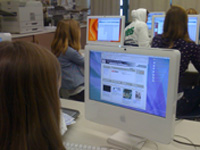What does the younger generation learn from the Web today? Which Web sites do they view as an important part of their cultural heritage and their world? The Library of Congress is helping answer these questions by empowering middle and high school students – the first generation to live their entire lives in a digital world – as "Web archivists."

Students at Miramonte High School select Web sites to archive.
During the spring of 2008, students from three schools in Louisiana, California and Illinois participated in a K-12 Web Archiving (external link) pilot to select and capture Web content. The National Digital Information Infrastructure and Preservation Program is working with the Library’s Teaching with Primary Sources program to support the pilot. Two NDIIPP partners, the Internet Archive (external link) and the California Digital Library (external link), are providing the tools and services for the project.
"Much of the record of the current generation's cultural heritage only exists in digital form. It only makes sense to include young people - our digital natives - in deciding what content is saved for future generations," said Elizabeth Ridgway, Director of Educational Outreach for the Library.
At each of the three schools, students created time capsules of Web content from their personal perspectives. They identified primary source Web sites, provided a brief description of the site and why the site was reflective of their interests and lives. Teachers facilitated the work during the two month crawl period. Students discovered that sites grow and change in unexpected ways, and learned to show how the Web inspires their daily lives. At the end of the project students reviewed and reflected on their choices.
"The program has helped students understand that primary sources are not just things of the past. Primary sources are created everyday and can exist in a variety of formats," said Ridgway. "The student descriptions give us valuable insight into how young people use the Internet and why they make the choices they do."
Surfing through the time capsules helps bring to light what content the digital natives find relevant and significant to archive. Journalism students at Miramonte High School (external link) in Orinda, California focused their collection on three areas: consumption, or "shopping online" sites; education-information sites; and recreation, or "entertainment on the Web." Miramonte’s teacher set up a blog (external link) to document their project.
Miramonte students chose, for example, the Contra Costa Times site as "the best source of information for local news," and "helpful for current event projects and for finding up to date political news." The New Yorker (external link) was selected for its "broad overview of our culture," and "its reliability and intellectual creativity." Urban Outfitters (external link) was picked because "it carries brand names and unique styles that are very popular among teenagers."
The project indicated that students can select, describe, and capture Web content in a manner that represents current social and behavioral trends. Kristine Hanna, Director of Web Archiving Services at Internet Archive, felt the pilot project was very successful, noting the subject matter of the Web sites selected. "The students archived Web sites we would have probably never known about," she said. "The uniqueness of the K-12 Web collections adds value to the historical Web record of the 21st century."
With the success of the pilot, the partners launched an expanded K-12 Web Archiving project for the 2008-09 academic school year. Ten schools from California, Illinois, Connecticut, South Carolina, Iowa, New Jersey, West Virginia, New York, and Virginia will archive primary source Web sites that reflect student lives and interests. Students will later revisit the archived collections to see how the sites have changed over time. This will help students gain a personal understanding about the tremendous challenges presented by archiving and preserving historical records in the ever-changing world of digital content.
